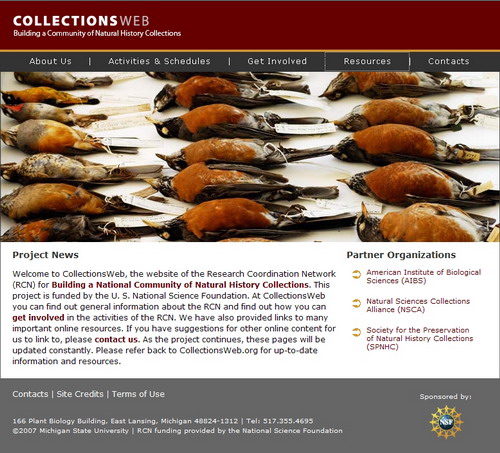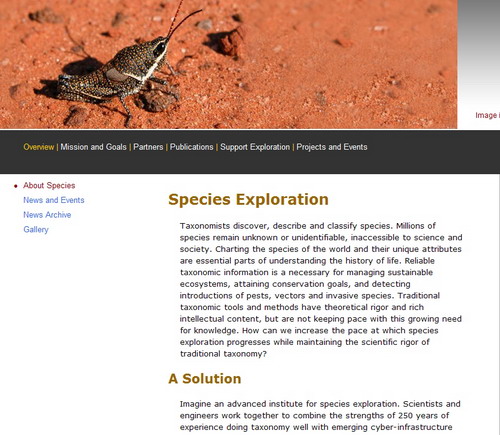
An Overview of Biodiversity Informatics
| By |
: |
Stanley D. Blum |
| |
|
California Academy of Sciences |
| First distributed |
: |
September 18, 2000 |
| This version |
: |
October 7, 2000 |
Preface
This overview of biodiversity informatics is strongly focussed on biological systematics and the work conducted in systematics collections (i.e., natural history museums). It does not address observational (monitoring) data, rare and endangered species, ecosystem characterization, threat assessment, and a host of other biodiversity issues.
Introduction
Regardless of what the All Species project sets as its ultimate goals, it is certain that the work will create large quantities of new information. Most people will actually experience the project's results not by coming into contact with newly discovered and described organisms, but by experiencing the new information generated about the organisms – everything from text, to pictures, diagrams, maps, sounds and video.
Ensuring that information flows efficiently, from creation, through analysis, into appropriate outputs, is the essence of biodiversity informatics – the application of information technology to the domain of biodiversity.
This overview of biodiversity informatics describes the main subject areas in biological systematics, their interrelationships, and the most important informatics projects in a given area. The subject areas are:
In each of these areas, I will discuss
- The nature and uses of the information
- How the data are captured and managed
- Status of data capture and management within the community (e.g., percent digitized)
- Significant projects for compiling data, developing software, etc.
Taxonomic Names and Classification
Nature and Uses of Names and Classification
Biological taxonomy – the scientific names of organisms – provides a global (at least internationally recognized) system of designating natural groups of organisms; i.e., species and higher taxa. Classifications assemble smaller groups into larger groups, and provide a way of making statements about or retrieving information about many species at a time. One of the first steps in communicating the discovery of a new kind of organism is to give it a name, and to infer what it is by classifying it – i.e., saying that it is a particular kind of something more general and perhaps already familiar.
| Examples of taxonomic names |
| Gorilla gorilla |
the name of a species |
|
| Scombridae |
the name of a family of fishes (tunas, mackerels, etc.); the family contains 15 genera and 49 valid/accepted species; 212 species names are "available" for these 49 species so (212 - 49 =) 163 of those names are synonyms. |
|
| |
– (From the ITIS database)
|
|
| |
| An example of a species in a classification |
| |
Kingdom Animalia animals Phylum Chordata chordates Subphylum Vertebrata vertebrates Class Mammalia mammals Order Primates primates Family Hominidae man-like primates Genus Gorilla Species Gorilla gorilla
|
|
| |
– (From the ITIS database) |
|
Defining a group of organisms (taxon) and naming it are conceptually distinct operations. Determining that a taxon is biologically meaningful or real is a question of scientific judgement and is subject to refutation. Determining what name should be applied to it is a matter of following the rules set forth in the relevant international code of nomenclature. (There are three; a code for microbiology, another for botany, and a third for zoology.)
Taxonomic names are created and put into use via publication. There are no requirements of scientific veracity, reasonableness, or qualifications of the author for a name to be effectively published and admitted into the universe of discourse. Once a name is published it has to be dealt with in subsequent works.
Scope of nomenclatural and classification data
There are an estimated 1.5 - 2 million known species. There are somewhere between one and two synonyms for every valid/accepted species (in addition the valid name). Compiling a list of scientific names for a major group takes years of effort. For the resulting list to represent real progress – something that doesn't have to be done again – each original publication must be reviewed (at least briefly) by a taxonomist and the decisions documented with supplemental information. Data gathered along with the name typically include the bibliographic reference, author(s), and date of publication. Additional information may include references to type specimens (institution and catalog number), type locality, and references to subsequent taxonomically significant publications.
Significant projects
Projects that aim to compile taxonomic databases fall into two major categories: nomeclators and checklists. A nomenclator is a compilation of all relevant names, but does not present opinions about which taxa are accepted or valid. A checklist represents determinations about which taxa are accepted or v
original link:
<a href='http://Apiaceae.github.io/blog/2009/03/18/%E7%94%9F%E7%89%A9%E5%A4%9A%E6%A0%B7%E6%80%A7%E4%BF%A1%E6%81%AF%E5%AD%A6%E4%BB%8B%E7%BB%8D/'>http://Apiaceae.github.io/blog/2009/03/18/%E7%94%9F%E7%89%A9%E5%A4%9A%E6%A0%B7%E6%80%A7%E4%BF%A1%E6%81%AF%E5%AD%A6%E4%BB%8B%E7%BB%8D/</a><br/>
written by <a href='http://Apiaceae.github.io'>Hooker</a>
posted at <a href='http://Apiaceae.github.io'>http://Apiaceae.github.io</a>
</p>








